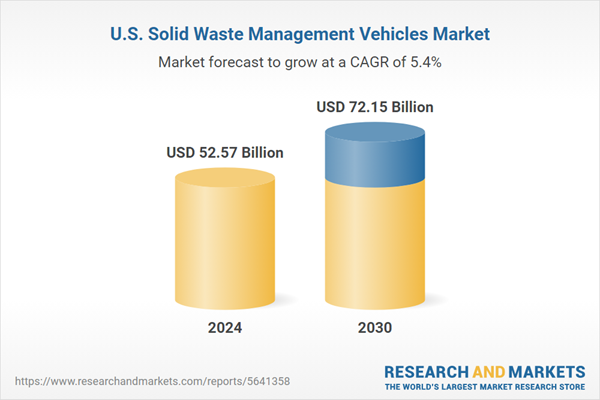Free Webex Call
The United States Solid Waste Management Vehicles Market was valued at USD 52.57 Billion in 2024, and is expected to reach USD 72.15 Billion by 2030, rising at a CAGR of 5.42%. This market is evolving rapidly, driven by the convergence of sustainability goals and advancements in vehicle technologies. Rising urbanization, industrial activity, and consumer waste generation have heightened the demand for efficient waste collection systems. To meet this demand, municipalities and private operators are increasingly upgrading their fleets with technologically advanced vehicles. Key developments such as automation, improved payload efficiency, and environmentally friendly propulsion systems are reshaping the operational strategies of waste management across the country, aligning logistics with environmental and regulatory objectives. Speak directly to the analyst to clarify any post sales queries you may have.
10% Free customizationThis report comes with 10% free customization, enabling you to add data that meets your specific business needs.
Market Drivers
Stringent Environmental Regulations
Environmental regulations across the U.S. are becoming more rigorous, aimed at reducing emissions and enhancing urban air quality. Mandates from agencies like the California Air Resources Board (CARB), federal fuel economy standards, and regional zero-emission targets are pressuring both public and private waste operators to phase out older diesel fleets in favor of cleaner alternatives. As compliance becomes non-negotiable, operators are increasingly adopting electric, hydrogen-powered, and hybrid waste collection vehicles. These regulatory measures, supported by financial incentives and rebates, are driving innovation and fleet modernization. The emphasis on emissions reduction is acting as a catalyst, propelling the deployment of advanced vehicles throughout both densely populated cities and rural areas.Key Market Challenges
High Capital Costs of Advanced Vehicles
A major hurdle facing the adoption of advanced solid waste management vehicles is the high upfront investment, especially for electric, hydrogen-powered, and automated models. Although these vehicles promise long-term operational savings, their initial cost remains two to three times higher than conventional diesel alternatives. For smaller municipalities and independent waste operators with limited budgets, this expense can be prohibitive - even with the availability of incentives. Additional infrastructure costs, such as those for charging stations or maintenance facilities, further increase the financial burden. The slow return on investment and need for technological infrastructure continue to challenge broad adoption, delaying fleet upgrades for many stakeholders.Key Market Trends
Electrification of Refuse Fleets
The shift toward electric refuse vehicles is gaining momentum in the United States, driven by sustainability targets and advancements in battery technology. Municipalities and private companies are increasingly incorporating electric trucks into their fleets to cut carbon emissions and reduce noise levels - particularly beneficial for urban neighborhoods. As battery range and cost efficiency improve, electric vehicles are becoming more viable for full-day operations. Supportive policies, ESG commitments, and federal/state-level incentives are further propelling this transition. Numerous cities have initiated pilot programs or made pledges to transition to fully electric fleets in the coming years. With more models entering the market and greater investments in charging infrastructure, electric refuse trucks are moving from trial phases to mainstream deployment.Key Market Players
- Autocar, LLC
- Casella Waste Systems, Inc.
- Clean Harbors, Inc.
- GFL Environmental Inc.
- Labrie Enviroquip Group
- McNeilus Truck and Manufacturing, Inc. (a subsidiary of Oshkosh Corporation)
- New Way Trucks (Scranton Manufacturing Company)
- Republic Services, Inc.
- The Heil Company (Environmental Solutions Group)
- Waste Management, Inc.
Report Scope:
In this report, the United States Solid Waste Management Vehicles Market has been segmented into the following categories, in addition to the industry trends which have also been detailed below:United States Solid Waste Management Vehicles Market, By Vehicle:
- Auto Tipper or Hopper Tipper
- Dumper Placer
- Earth Moving Equipment
- Garbage Compactor Truck
United States Solid Waste Management Vehicles Market, By Propulsion:
- CNG/LPG
- Electric
- Internal Combustion Engine (Diesel, Petrol)
United States Solid Waste Management Vehicles Market, By Application:
- Commercial
- Industrial
- Municipal
- Residential
United States Solid Waste Management Vehicles Market, By Region:
- South
- Midwest
- West
- Northeast
Competitive Landscape
Company Profiles: Detailed analysis of the major companies present in the United States Solid Waste Management Vehicles Market.Available Customizations:
United States Solid Waste Management Vehicles Market report with the given market data, TechSci Research, offers customizations according to the company’s specific needs. The following customization options are available for the report.Company Information
- Detailed analysis and profiling of additional market players (up to five).
This product will be delivered within 1-3 business days.
Table of Contents
1. Introduction
2. Research Methodology
3. Executive Summary
4. United States Solid Waste Management Vehicles Market Outlook
5. South United States Solid Waste Management Vehicles Market Outlook
6. Midwest United States Solid Waste Management Vehicles Market Outlook
7. West United States Solid Waste Management Vehicles Market Outlook
8. Northeast United States Solid Waste Management Vehicles Market Outlook
9. Market Dynamics
15. Competitive Landscape
Companies Mentioned
- Autocar, LLC
- Casella Waste Systems, Inc.
- Clean Harbors, Inc.
- GFL Environmental Inc.
- Labrie Enviroquip Group
- McNeilus Truck and Manufacturing, Inc. (a subsidiary of Oshkosh Corporation)
- New Way Trucks (Scranton Manufacturing Company)
- Republic Services, Inc.
- The Heil Company (Environmental Solutions Group)
- Waste Management, Inc.
Table Information
| Report Attribute | Details |
|---|---|
| No. of Pages | 80 |
| Published | July 2025 |
| Forecast Period | 2024 - 2030 |
| Estimated Market Value ( USD | $ 52.57 Billion |
| Forecasted Market Value ( USD | $ 72.15 Billion |
| Compound Annual Growth Rate | 5.4% |
| Regions Covered | United States |
| No. of Companies Mentioned | 10 |









